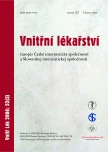Sodium Hyaluronate and an Iodine Complex - Hyiodine® - New Method of Diabetic Defects Treatment
Authors:
L. Sobotka 1; V. Velebný 2; A. Šmahelová 1; M. Kusalová 1
Authors‘ workplace:
Klinika gerontologická a metabolická Lékařské fakulty UK a FN, Hradec Králové, přednosta prof. MUDr. Luboš Sobotka, CSc.
1; Contipro, a. s., Dolní Dobrouč, ředitel RNDr. Vladimír Velebný
2
Published in:
Vnitř Lék 2006; 52(5): 417-422
Category:
Diabetes and other subjects (infection, dermatovenerology and rheumatology) Hradec Králové 3 to 4 June 2005
Overview
Complicated diabetic defects are difficult to heal and frequently result in leg amputation. We have developed a new and unique system for wound treatment, which is based on combination of high molecular weight sodium hyaluronate with an iodine complex - Hyiodine®. The aim of our study was to assess the effect of this new method of wound dressing on infected diabetic defects healing.
Methods:
The effect of Hyiodine® was studied on 22 patients suffering from complicated foot diabetic wounds. Hyiodine® was either spread directly over the wound, or (more frequently) gauze was immersed in Hyiodine® and then put on/into the wound. Then several layers of dry gauze covered the wound.
Results:
Within 2 - 6 weeks after the onset of treatment all but two defects were filled with granulation tissue. Complete healing was evident in 18 patients within 6 - 20 weeks after the start of treatment, depending on the wound character, localization and extent. Two patients are still treated by Hyiodine®, and significant improvement is apparent on their wound. Treatment was not successful in two subjects with ischemic defects due to simultaneous arterial occlusion.
Conclusions:
We can conclude that the hyaluronan-iodine complex Hyiodine® is efficient method for treatment of difficult to heal diabetic defects without complete arterial occlusion.
Key words:
wound healing - diabetes mellitus - diabetic ulcer - hyaluronan - iodine - Hyiodine®
Sources
1. Piaggesi A. Research development in the pathogenesis of neuropathic diabetic foot ulceration. Curr Diab Rep 2004; 4 : 419-423.
2. Kampfer H, Schmidt R, Geisslinger G et al. Wound inflammation in diabetic ob/ob mice: functional coupling of prostaglandin biosynthesis to cyclooxygenase-1 activity in diabetes-impaired wound healing. Diabetes 2005; 54 : 1543-1551.
3. Ahmed N. Advanced glycation endproducts-role in pathology of diabetic complications. Diabetes Res Clin Pract 2005; 67 : 3-21.
4. Arana V, Paz Y, Gonzalez A et al. Healing of diabetic foot ulcers in L-arginine-treated patients. Biomed Pharmacother 2004; 58 : 588-597.
5. Komesu MC, Tanga MB, Buttros KR et al. Effects of acute diabetes on rat cutaneous wound healing. Pathophysiology 2004; 11 : 63-67.
6. Graf J, Neusel E, Schneider E et al. Intra-articular treatment with HA in osteoarthritis of the knee joint: a controlled clinical trial versus mucopolysaccharide polysulfuric acid ester. Clin Exp Rheumatol 1993;11 : 367-373.
7. Balazs EA, Watson D, Duff IF et al. Hyaluronic acid in synovial fluid: I: molecular parameters of hyaluronic acid in normal and arthritic human fluids. Arthritis Rheum 1967; 10 : 357-376.
8. Toole BP, Gross J. The extracellular matrix of the regenerating newt limb: synthesis and removal of hyaluronate prior to differentiation. Dev Biol 1971; 25 : 57-77.
9. West DC, Hampson IN, Arnold F et al. Angiogenesis induced by degradation products of hyaluronic acid. Science 1985; 228 : 1324-1326.
10. Chen WYJ, Abatangelo G. Functions of hyaluronan in wound repair. Wound Repair Regen 2000; 7 : 79-89.
11. McKee CM, Penno MB, Cowman M et al. Hyaluronan (HA) fragments induce chemokine gene expression in alveolar macrophages: the role of HA size and CD-44. J Clin Invest 1996; 98 : 2403-2413.
12. Takahashi K, Takeuchi J, Takahashi T et al. Effects of sodium hyaluronate on epithelial healing of the vesical mucosa and vesical fibrosis in rabbits with acetic acid induced cystitis. J Urol 2001; 166 : 710-713.
13. Ishima M, Wada Y, Sonoda M et al. Effects of hyaluronan on the healing of rabbit meniscus injured in the peripheral region. J Orthop Sci 2000; 5 : 579-584.
14. Gomez S, Herreras JM, Merayo J et al. Effect of hyaluronic acid on corneal haze in a photorefractive keratectomy experimental model. J Refract Surg 2001; 17 : 549-554.
15. Edmonds M, Bates M, Doxford M et al. New treatments in ulcer healing and wound infection. Diabetes Metab Res Rev 2000; 16(Suppl 1): S51-S54.
Labels
Diabetology Endocrinology Internal medicineArticle was published in
Internal Medicine

2006 Issue 5
Most read in this issue
- Diabetic skin changes from the dermatological point of view
- Glucocorticoids and diabetes mellitus
- Diffuse idiopathic skeletal hyperostosis and its relation to metabolic parameters
- Skin complications of diabetes mellitus therapy
